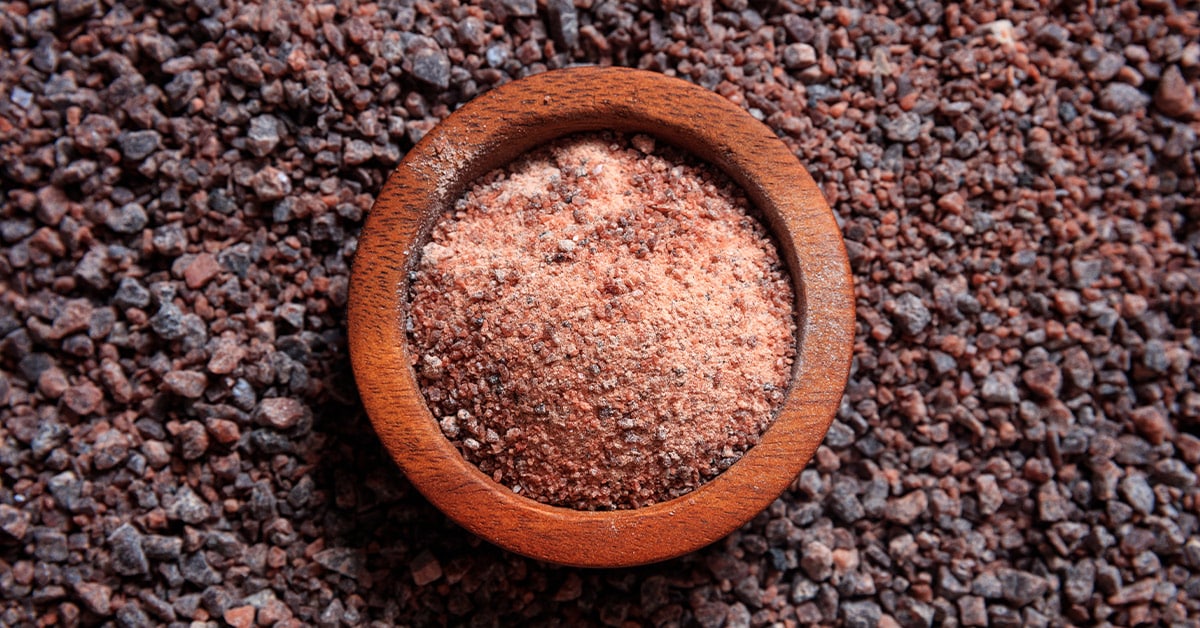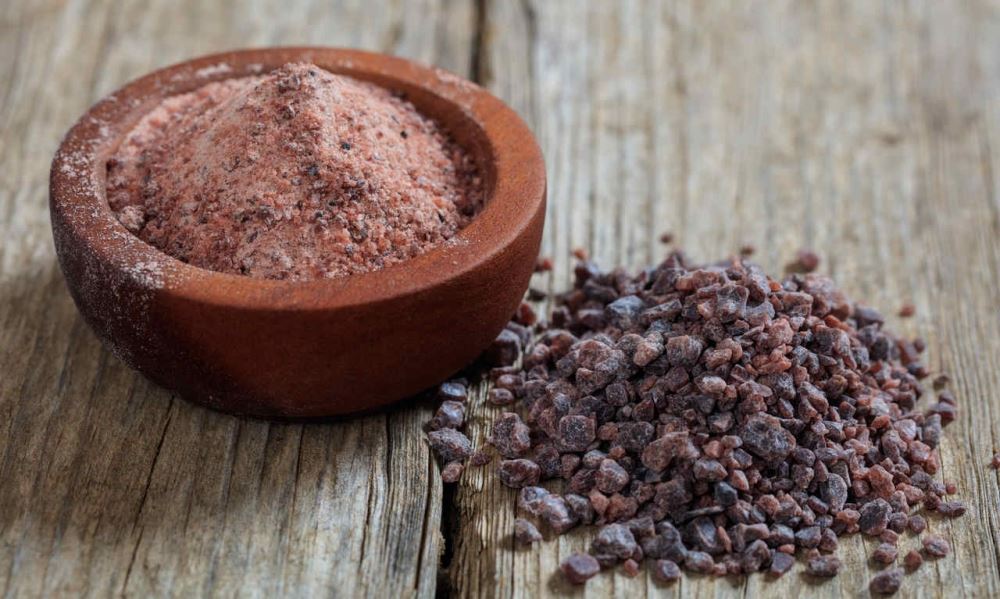Blog
What is the importance of Kala Namak?

Kala Namak, literally translating to “black salt” in Hindi, is more than just a dark speck on your spice rack. This volcanic rock salt, boasting a unique flavor profile and potential health benefits, holds a significant place in Indian cuisine and culture. Let’s delve deeper into the world of Kala Namak, exploring its origins, unique characteristics, and the multifaceted importance it holds.
A Geological Journey:
Kala Namak’s story begins deep within the earth. Unlike most table salts derived from seawater, Kala Namak originates from volcanic rock deposits found in the regions of the Himalayas, particularly in Pakistan. These deposits are rich in various minerals, including sodium chloride (common table salt), sodium sulfate, sodium thiosulfate, and iron sulfide. The specific combination of these minerals, along with the unique processing methods, contributes to Kala Namak’s distinct color and flavor profile.
From Rock to Plate: The Production Process
The traditional method of producing Kala Namak involves a fascinating and labor-intensive process. Volcanic rock salt is mined and then crushed into smaller pieces. These fragments are then mixed with various organic materials like seashells, wood chips, and even animal dung. This mixture is then piled high and left to ferment for several weeks. The fermentation process plays a crucial role, as it breaks down the organic materials and contributes to the development of the distinctive flavor and aroma of Kala Namak. Following fermentation, the mixture is heated, often in large clay ovens, to drive off moisture and solidify the salt. The resulting product is a dark-colored, rock-like salt with a complex and intriguing flavor profile.
A Flavor Profile Beyond Salty:
Kala Namak transcends the simple taste of table salt. While it does offer a salty element, its true magic lies in its complex interplay of other flavors. The presence of sulfur compounds creates a unique eggy or pungent aroma, often described as resembling boiled eggs or even slightly like garlic. This characteristic aroma sets Kala Namak apart from other salts. However, alongside the eggy notes, Kala Namak offers a subtle sweetness and a hint of bitterness, creating a truly multifaceted flavor experience.
Beyond Flavor: The Potential Health Benefits of Kala Namak
The unique mineral composition of Kala Namak has led some to believe it offers potential health benefits. These benefits, however, are not definitively proven by scientific research and require further investigation. Here’s a glimpse into some potential benefits:
-
Digestive Aid: The presence of sodium bicarbonate (baking soda) in Kala Namak might contribute to its potential role as a digestive aid. Baking soda is known to neutralize stomach acid, potentially offering relief from heartburn or indigestion.
-
Electrolyte Balance: Kala Namak is a good source of electrolytes, including sodium, potassium, and magnesium. Electrolytes play a crucial role in maintaining proper hydration and muscle function.
-
Blood Pressure Regulation: While high sodium intake can be detrimental to blood pressure, some studies suggest that specific components in Kala Namak, like potassium and magnesium, might help regulate blood pressure. However, moderation is key, and individuals with high blood pressure should consult their healthcare professional before consuming Kala Namak.
A Culinary Gem in Indian Cuisine:
Kala Namak holds a special place in Indian cuisine. Its unique flavor profile adds depth and complexity to countless dishes. In North India, it’s a staple ingredient in chaat masala, a tangy and flavorful street food spice blend. It enhances the taste of dals (lentil stews) and curries, and its eggy aroma can be used to create vegan dishes with a similar flavor profile to scrambled eggs. South India also incorporates Kala Namak in dishes like pani puri, a savory street food with a tangy and slightly eggy flavor.
More Than Just a Taste: The Cultural Significance of Kala Namak
The importance of Kala Namak extends beyond its culinary applications. In Ayurveda, the traditional Indian system of medicine, Kala Namak is considered a cooling spice that can help balance the body’s internal heat. It’s also believed to have laxative properties and is sometimes used as a natural remedy for constipation. Additionally, Kala Namak’s unique color and association with volcanic rock formations have imbued it with a certain mystique and cultural significance in some regions of India.
A Final Note:
Kala Namak, with its intriguing history, unique flavor profile, and potential health benefits, offers a compelling reason to explore its possibilities in the kitchen. While further research is needed to confirm its specific health benefits, its undeniable importance in Indian cuisine and culture remains. So, the next time you encounter this intriguing black salt, embrace its complex flavors and discover the world of culinary and cultural significance it embodies.
FAQ:
- What does “Kala Namak” mean?
Kala Namak translates to “black salt” in Hindi. It’s a volcanic rock salt with a unique flavor profile and potential health benefits.
- Where does Kala Namak come from?
Unlike table salt, Kala Namak originates from volcanic rock deposits found in the Himalayas, particularly in Pakistan.
- How is Kala Namak produced?
Traditionally, volcanic rock salt is mixed with organic materials and fermented for weeks. This process contributes to its distinctive flavor and aroma.
- What does Kala Namak taste like?
Beyond its salty element, Kala Namak offers a complex interplay of flavors. It has a unique eggy or pungent aroma with hints of sweetness and bitterness.
- Are there any health benefits associated with Kala Namak?
Some believe Kala Namak may aid digestion, balance electrolytes, or even regulate blood pressure. However, more research is required.
- How is Kala Namak used in Indian cuisine?
It’s a staple ingredient in chaat masala, enhances dals and curries, and can be used to create vegan dishes with an eggy flavor profile.
- Does Kala Namak have any significance beyond culinary uses?
Yes! In Ayurveda, it’s considered a cooling spice and may be used as a natural laxative. Its color and volcanic origin hold cultural significance in some regions of India.
- Is Kala Namak a good substitute for table salt?
You can use it in moderation as a finishing salt due to its strong flavor. However, it wouldn’t be a direct replacement for table salt in all recipes.
- Can anyone consume Kala Namak?
Individuals with high blood pressure should consult their healthcare professional before consuming Kala Namak due to its sodium content.
- Where can I find Kala Namak?
Look for it in the international section of supermarkets, ethnic grocery stores, or online retailers specializing in international ingredients.




I came here to read the comments after reading the blog, but many people here have told that the blog is really very good. The third love is less. Thank you very much to the voter.
If you’re not reading this blog, you’re missing out big time. It’s hands down the best one out there
I always look forward to reading new posts on this blog.
Excellent article! Your writing style is engaging and the content is very informative. Thank you for sharing.
This post answered all the questions I had about the topic.
I can’t wait to see what you write about next!